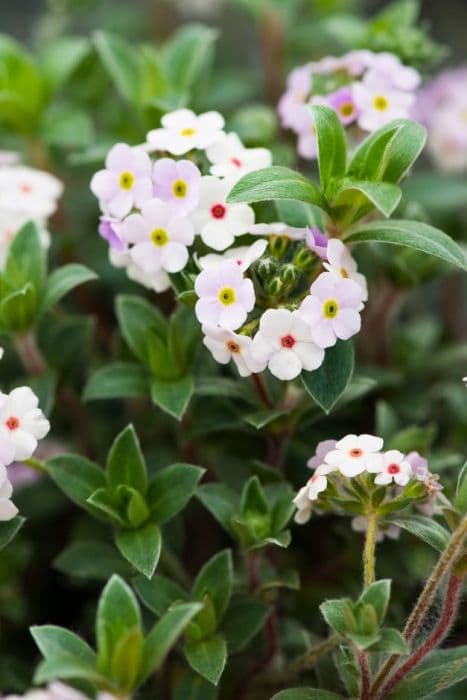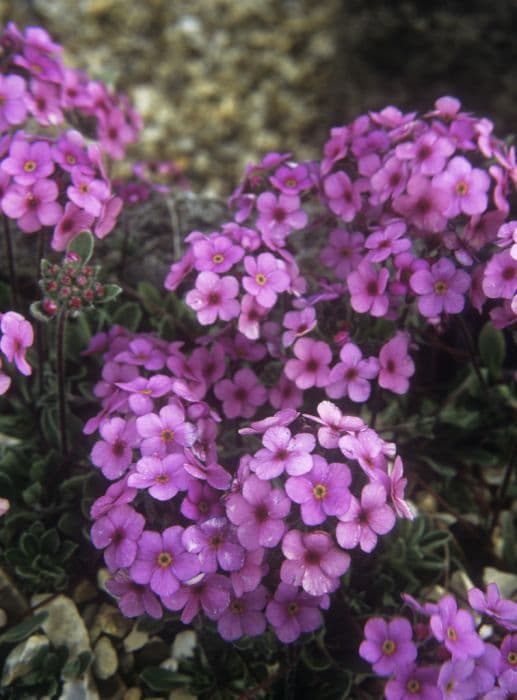Auricula Primula auricula 'Susannah' (Au/d)

ABOUT
Primula auricula 'Susannah' is a charming plant that bears exquisite flowers with a unique appearance. The blossoms display a vivid color palette, with a rich, deep purple hue at the center that gradually transitions to a softer lavender towards the edges. Surrounding the central eye, one can find a striking golden-yellow or cream color, forming a vivid halo that contrasts beautifully with the purple. The flowers themselves are comprised of round-edged, velvety petals that come together to form a circular shape, contributing to an overall look of delicacy and finesse. The leaves of the plant add to its attractiveness with their attractive form and texture. They possess a slightly fleshy character and are often dusted with a powdery, whitish bloom, giving them a silvery appearance. This bloom is known for its protective qualities as well as its ornamental appeal. Arranged in a low rosette, the leaves provide a lush, green backdrop that enhances the visual impact of the bright and showy flowers. The overall presentation of Primula auricula 'Susannah' is one of elegance and vibrant color, making it a delightful addition to any garden setting where it can be appreciated for its ornamental qualities. Its rich colors and engaging textures offer visual interest, and the unique combination of its flower and foliage features make it a standout among flowering plants.
About this plant
 Names
NamesFamily
Primulaceae
Synonyms
Bear's Ear Auricula, Mountain Cowslip, Bear's Ear Primrose
Common names
Primula auricula 'Susannah'
 Toxicity
ToxicityTo humans
Bear's ear, the common name of Primula auricula 'Susannah', generally has low toxicity to humans. If ingested, it may cause mild stomach upset, but significant or life-threatening toxicity is rare. Handling the plant might cause skin irritation or allergic reactions in sensitive individuals due to the presence of certain chemicals like primin. Washing the affected area with soap and water and seeking medical advice if symptoms persist or worsen is recommended.
To pets
Bear's ear is also considered to have low toxicity to pets. If your pet ingests part of the plant, it may experience mild gastrointestinal upset, such as vomiting or diarrhea. It is generally not life-threatening, but if you notice any adverse reactions or if your pet consumes a large amount of the plant, it is advisable to contact your veterinarian. Additionally, like in humans, the plant can cause skin irritation in pets, so it's wise to monitor them for any allergic reactions after contact and seek veterinary assistance if necessary.
 Characteristics
CharacteristicsLife cycle
Perennials
Foliage type
Evergreen
Color of leaves
Green
Flower color
Yellow
Height
6 inches (15 cm)
Spread
6 inches (15 cm)
Plant type
Herb
Hardiness zones
5
Native area
Europe
Benefits
 General Benefits
General Benefits- Ornamental Value: Adds vibrant, eye-catching colors to gardens and landscapes during its blooming season.
- Low Maintenance: Requires minimal care once established, which is ideal for busy gardeners or those new to gardening.
- Drought Tolerance: Once acclimated, it can withstand periods of dryness, reducing the need for frequent watering.
- Cold Hardy: Able to survive in cooler climates, making it a suitable choice for gardens in temperate zones.
- Attracts Wildlife: Flowers can attract beneficial pollinators such as bees and butterflies, which are essential for the health of the garden ecosystem.
- Container Gardening: Well-suited for pot culture, it allows those with limited space to enjoy its beauty on patios or balconies.
- Seasonal Interest: Provides early spring bloom, which can help to break up the monotony of winter and signal the start of a new growing season.
- Compact Growth: Its relatively small size makes it an excellent choice for rock gardens, borders, or as ground cover.
 Medical Properties
Medical Properties- This plant is not used for medical purposes.
 Air-purifying Qualities
Air-purifying QualitiesThis plant is not specifically known for air purifying qualities.
 Other Uses
Other Uses- Auricula Theater Display: 'Susannah' can be showcased in a traditional auricula theater, which is a tiered staging specifically designed to display these plants during the blooming season.
- Floral Art: The vivid colors and unique patterned flowers of 'Susannah' make it a stunning choice for intricate floral art and designs.
- Education: Primula auricula 'Susannah' can be used as an educational tool to teach about plant hybridization and genetic variation within species.
- Photographic Subject: With its striking appearance, 'Susannah' is an excellent subject for botanical photography and illustration.
- Gift Plant: Due to its beauty and rarity, 'Susannah' is often given as a unique gift to plant enthusiasts and collectors.
- Alpine Gardens: 'Susannah' is suitable for alpine and rock gardens, adding color and interest with its distinct blooms.
- Drama Productions: Its old-world charm makes 'Susannah' a suitable prop for period dramas or theatrical productions set in historical times.
- Bee Garden: Primula auricula 'Susannah', like other primulas, can contribute to a bee-friendly garden as an early source of nectar in the spring.
- Miniature Gardening: 'Susannah' can be used in miniature or fairy gardens due to its compact size and attractive foliage and blooms.
- Container Gardening: This plant is well-suited for container gardening, offering bright splashes of color on balconies or patios.
Interesting Facts
 Feng Shui
Feng ShuiThe Auricula is not used in Feng Shui practice.
 Zodiac Sign Compitability
Zodiac Sign CompitabilityThe Auricula is not used in astrology practice.
 Plant Symbolism
Plant Symbolism- Unique Beauty: The Primula auricula, often referred to as Auricula, is known for its unique patterns and bright, diverse colors, symbolizing the beauty in uniqueness and individuality.
- Patience: Auriculas can take time to establish and bloom, representing the virtue of patience in growth and development.
- Perseverance: They can endure harsh conditions, often thriving in alpine climates, symbolizing perseverance and the ability to overcome challenges.
- Cherished Friendship: Historically, Auriculas have been collected and exchanged among enthusiasts, symbolizing the cultivation of cherished friendships and shared interests.
- Hope and New Beginnings: Blooming early in spring, Auriculas signify hope and the promise of new beginnings as one of the season's first flowers.
 Water
WaterThe Auricula Primrose should be watered thoroughly, allowing the soil to become slightly dry to the touch between waterings, typically every 3-7 days depending on the environmental conditions such as temperature and humidity. When watering, aim to provide the plant with approximately 1 inch of water, using a gentle stream to avoid disturbing the soil or foliage. During the active growing season, in spring and summer, the auricula might require more frequent watering, especially if outdoors in warmer weather. It is crucial not to let the plant sit in water as this could lead to root rot, so ensure any excess water is allowed to drain away.
 Light
LightAuricula Primroses prefer bright, indirect light or partial shade, as direct sunlight can scorch their leaves. The ideal location would be in an area that receives morning light or filtered light through a translucent curtain. If grown outdoors, they thrive in a spot that is sheltered from the hot afternoon sun but still gets enough light to promote healthy growth.
 Temperature
TemperatureAuricula Primroses are hardy in a range of temperatures but flourish best when daytime temperatures are between 50-75°F. They can tolerate temperatures as low as 40°F and up to about 80°F. To ensure optimal growth and flowering, keep them in an environment that avoids temperature extremes and protects them from frost.
 Pruning
PruningPruning Auricula Primroses is important for removing dead or yellowing leaves and spent flowers to promote new growth and maintain a tidy appearance. The best time for pruning is after blooming in late spring or early summer. Regularly deadheading the flowers will encourage more blooms and extend the flowering period.
 Cleaning
CleaningAs needed
 Soil
SoilThe Auricula Primrose prefers a well-draining soil with a mixture of loam, peat, and sand, ideally in equal parts. It requires a soil pH ranging from slightly acidic to neutral, approximately between 6.0 and 7.0.
 Repotting
RepottingAuricula Primroses should be repotted annually to replenish the soil and accommodate growth, ideally done in the fall after flowering has ceased or in early spring.
 Humidity & Misting
Humidity & MistingAuricula Primrose thrives best in moderate to high humidity levels but will tolerate lower humidity if other growing conditions are met.
 Suitable locations
Suitable locationsIndoor
Place in bright, indirect light and keep soil moist.
Outdoor
Partial sun to light shade; protect from extreme heat.
Hardiness zone
4-8 USDA
 Life cycle
Life cyclePrimula auricula 'Susannah' (Au/d), commonly known as Bear's Ear, starts its life cycle when seeds are sown in containers in a cold frame as soon as ripe. The seedlings will germinate, typically requiring light for optimal growth, and after they've developed true leaves, they are pricked out into individual pots. The young plants grow by forming a rosette of leaves at the soil surface and then by the second year, they produce flowering stems in spring or early summer. The Bear's Ear flowers are characterized by their vivid colors and ornamental appeal, attracting pollinators for the next life stage – seed formation. Once pollinated, the flowers develop into capsules containing numerous small seeds. Following seed dispersal, the plant often goes into a state of dormancy during the winter months, only to resume growth with the return of warmer temperatures in the spring.
 Propogation
PropogationPropogation time
Spring-Early Summer
The common name for Primula auricula 'Susannah' is Auricula Primrose, a beautiful alpine plant known for its unique flowers. The most popular method of propagating Auricula Primrose is by offset division which is typically done in late summer after the flowering period has ended. To propagate Auricula Primrose by division, carefully remove the plant from its pot or garden location. Gently separate the offsets, which are the small rosettes that form at the base of the parent plant. Each offset should have some roots attached. Replant the offsets into pots with a well-draining soil mix, and keep them well-watered as they establish themselves. Once the new plants have formed a robust root system, they can be transplanted to their final location. This method allows for the faithful reproduction of the parent plant, as each division is genetically identical.









